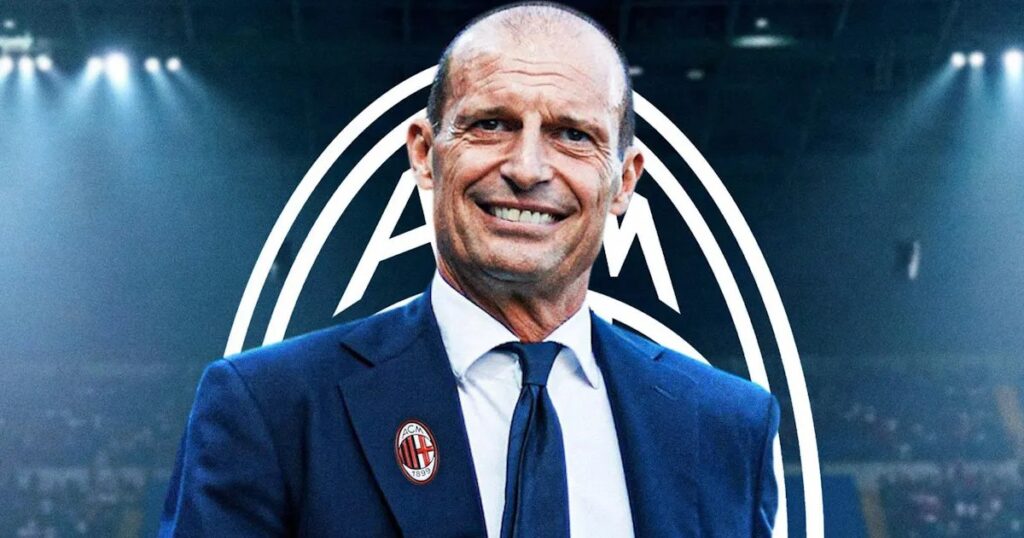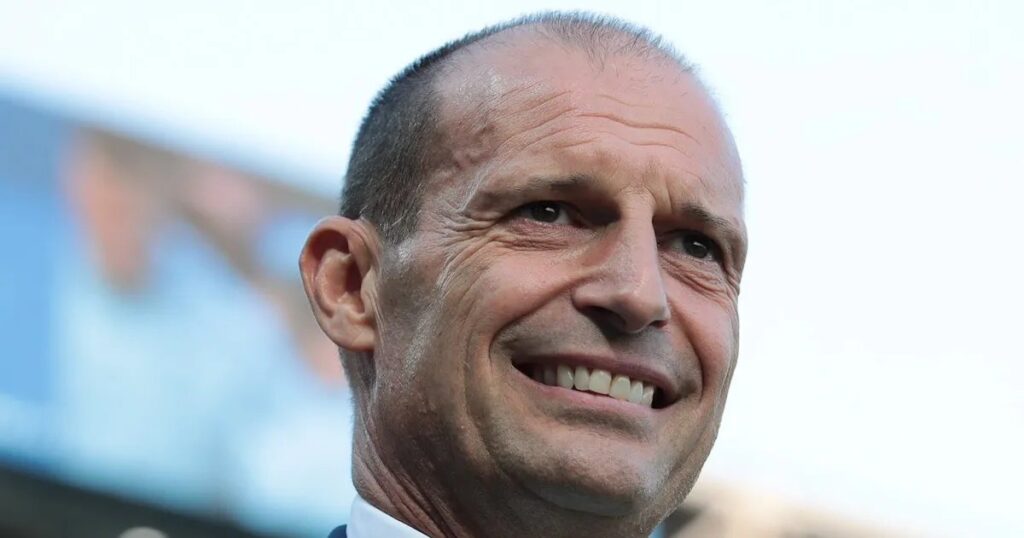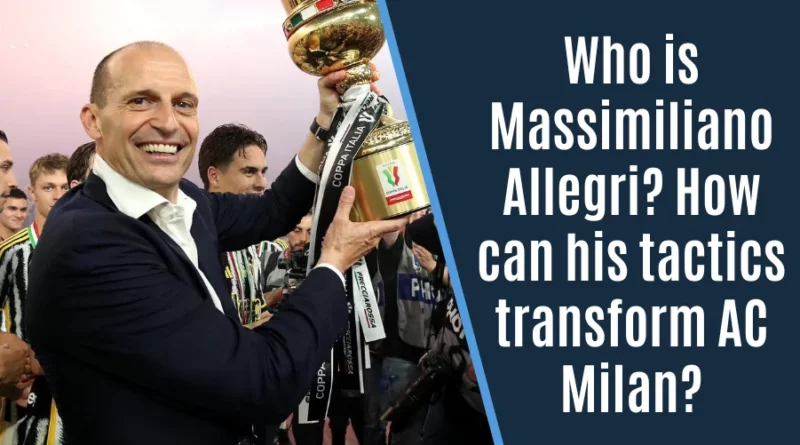Who is Massimiliano Allegri? How Can His Tactics Transform AC Milan?
When suddenly Fabrizio Romano drops one of his trademark “Here we go!” bombs, Massimiliano Allegri is heading back to AC Milan. After more than a decade away from the club where he first made his mark as a top-level manager, Allegri is returning to try and fix what’s been a pretty messy situation at the San Siro. The Italian maestro, who’s spent recent years working his magic at Juventus (with varying degrees of success), has put pen to paper on a new deal with the Rossoneri. Frankly, it’s exactly the kind of move that gets football nerds like us properly excited.
What makes this appointment so intriguing is the timing. Milan has just endured what can only be described as a nightmare season, and they needed someone with a serious pedigree to come in and sort things out. Enter Allegri, a manager who knows Serie A like the back of his hand and has a trophy cabinet that would make most coaches weep with envy.
The 57-year-old met with all the right people, got all the details sorted, and now we’re looking at what could be one of the most fascinating managerial appointments in recent memory. It’s not just about bringing in a new coach; it’s about launching an entirely new project with someone who understands both the pressures and the potential of managing a club of Milan’s stature.

Massimiliano Allegri Tactics and Style of Play
Now, let’s get into the juicy stuff – how does this guy actually set up his teams? If you’ve watched Allegri’s sides over the years, you’ll know he’s not your typical one-formation, one-style kind of manager. The man is basically a tactical chameleon, and that’s probably what makes him so bloody effective. What really sets Allegri apart is his tactical intelligence and his ability to build upon existing foundations rather than ripping everything up and starting from scratch.
During his legendary stint at Juventus, he initially kept Antonio Conte’s successful 3-5-2 formation but then gradually made it his own. Think of it like inheriting a really good recipe from your grandmother and then adding your own secret ingredients – you respect what worked before, but you’re not afraid to make improvements. Under Allegri, Juventus became slightly less manic in their pressing but way more patient and possession-focused, which is exactly the kind of mature approach that can work wonders when you’ve got experienced players who understand the game.
Massimiliano Allegri Formation
The beauty of Massimiliano Allegri tactics lies in his versatility, and I mean serious versatility, not just the kind where a manager claims he can play 4-4-2 and 4-3-3. This guy has genuinely mastered multiple formations, seamlessly switching between 4-3-1-2, 4-4-2, 4-3-3, and his trademark 3-5-2 depending on what the situation demands. What’s particularly clever is how he uses these formation changes mid-game – you know those moments when you’re watching a match and suddenly think “hang on, that team looks completely different”? That’s classic Allegri. He’s famous for switching to a 3-5-2 in the final 20 minutes of tight games to shore things up, or deploying two deep defensive lines when facing possession-heavy teams.
One of the most fascinating aspects of his tactical evolution came during the 2016-17 season when he started using a 4-2-3-1 formation, particularly for European matches. This wasn’t just a change for the sake of change, it was tactical innovation designed to get the best out of specific players. He’d have Gonzalo Higuaín up front as the main striker, with Paulo Dybala pulling the strings as a number 10, supported by box-to-box midfielders like Sami Khedira alongside deep-lying playmakers. The really clever bit was how he used Mario Mandžukić as a left-sided attacking midfielder, utilizing the Croatian’s work rate and aerial ability in wider areas – it’s the kind of positional flexibility that modern football demands.
His tactical philosophy also extends to how he manages space and movement, particularly in the final third. Allegri loves having his forwards and wingers drop back between the lines, creating proper dilemmas for opposing defenders. If defenders don’t follow the dropping movement, his players can receive and turn unmarked. If they do follow, space opens up behind them for someone else to exploit – it’s like a chess match where every move creates multiple possibilities. Having players like Miralem Pjanić in midfield during his Juventus days was crucial for this system, as they could read these situations and deliver the perfect pass at exactly the right moment.
ALSO READ: Who Is Erik ten Hag? Learn About His Transformative Tactics
Massimiliano Allegri Trophies and Achievements
Right, let’s talk silverware – because when you’re evaluating whether a manager is the real deal, you’ve got to look at what’s actually sitting in their trophy cabinet. And honestly, Allegri’s collection is pretty damn impressive. The man has basically been hoovering up trophies throughout his managerial career, particularly during his time at Juventus, where he established himself as one of the most successful coaches in modern Serie A history.
During his spells at various clubs, but most notably at Juventus, Allegri has racked up an absolutely ridiculous number of domestic trophies. We’re talking about Massimiliano Allegri trophies, including six Serie A titles, five Coppa Italia victories, and three Super Cup wins – numbers that would make most managers retire happy. What’s particularly impressive is the consistency of his success; this isn’t a case of one good season followed by years of mediocrity. The guy was winning Serie A titles year after year, turning Juventus into an absolute domestic powerhouse during his tenure. Here’s a look at Massimiliano Allegri trophies cabinet:
| Competition | Status | Count | Year |
|---|---|---|---|
| Serie A | Winner | 6x | 2018/2019, 2017/2018, 2016/2017, 2015/2016, 2014/2015, 2010/2011 |
| Serie A | Runner up | 1x | 2011/2012 |
| Coppa Italia | Winner | 5x | 2023/2024, 2017/2018, 2016/2017, 2015/2016, 2014/2015 |
| Coppa Italia | Runner up | 1x | 2021/22 |
| Super Cup | Winner | 3x | 2018/2019, 2015/2016, 2011/2012 |
| Super Cup | Runner up | 4x | 2021/2022, 2017/2018, 2016/2017, 2014/2015 |
| UEFA Champions League | Runner up | 2x | 2016/2017, 2014/2015 |
Is Massimiliano Allegri the right fit for AC Milan?

Now this is where things get really interesting, because Milan’s situation right now is… well, let’s be brutally honest, it’s been pretty rough. The 2024/25 season was essentially a disaster by Milan standards – the kind of campaign that has fans questioning everything from the transfer strategy to the training methods. When a club of Milan’s stature and history is struggling to maintain consistency and competing for major trophies, you know something fundamental needs to change. The appointment of Allegri feels like an admission that the previous approach wasn’t working and that it’s time to bring in someone with serious experience and a proven track record of turning things around.
What makes Allegri potentially perfect for this situation is his track record of inheriting challenging situations and making them work. Remember, when he took over at Juventus, he was following Antonio Conte, who had already built a winning machine – the pressure was enormous, and many expected him to fail. Instead, he not only maintained that success but actually enhanced it, adding his own tactical innovations while preserving what was already working well. This ability to build incrementally rather than destroying and rebuilding from scratch could be exactly what Milan needs right now.
However, there are some legitimate concerns about whether this appointment will work out. First, there’s the question of squad compatibility – Allegri’s preferred tactical systems require specific types of players, and Milan’s current roster might not be perfectly suited to his methods. His preference for organized defending and disciplined positioning means players need to buy into a more structured approach, which isn’t always easy when you’re dealing with modern footballers who might be used to more freedom. Additionally, the pressure at Milan is different from what he experienced at Juventus; at Juve, he was managing a team that was already winning, while at Milan, he’s expected to restore a fallen giant to its former glory.
The external factors are also worth considering. Milan’s ownership situation, the financial constraints of modern football, and the competitive landscape of Serie A have all changed significantly since Allegri’s last stint with the club. The league is more competitive now, with teams like Napoli, Inter, and others capable of challenging for titles, which means his tactical approach will need to be even more refined. There’s also the Champions League qualification pressure – Milan needs to be competing at the highest level, and Allegri’s mixed European record, despite those final appearances, might be a concern for some fans and board members.
How could AC Milan lineup look under Massimiliano Allegri?
This is where it gets properly exciting for Milan fans, because Allegri’s tactical flexibility means there are several ways he could set up this team. Based on his preferred systems and the current Milan squad, I’d expect him to primarily use either a 4-2-3-1 or a 3-5-2 formation, depending on the opposition and the specific match situation. Let’s start with the 4-2-3-1, which could really suit Milan’s current personnel and allows for the kind of tactical variations that Allegri loves to implement.
In a typical 4-2-3-1 setup, you’d probably see Mike Maignan in goal – no surprises there, as he’s been one of Milan’s most consistent performers. The back four would likely feature Theo Hernández at left-back, with his pace and attacking threat perfectly suited to Allegri’s system, where full-backs are encouraged to get forward and support attacks.
The center-back partnership could be built around Fikayo Tomori and whoever emerges as his best partner, with the emphasis on defensive solidity that Allegri demands. On the right, someone like Alessandro Florenzi or Davide Calabria could provide the defensive stability and attacking support that the system requires.
The midfield is where things get really interesting, because Allegri’s 4-2-3-1 typically features two deep-lying midfielders who provide both defensive cover and the ability to launch attacks. Players like Tijjani Reijnders and Yacine Adli could be perfect for these roles, offering the work rate and passing ability that Allegri values.
The number 10 position is crucial in this system – it’s where creativity meets tactical discipline, and whoever plays there needs to be able to drop between the lines to create space while also providing the final pass. This could be an area where Milan might need to strengthen, depending on how Allegri views the current options. Massimiliano Allegri formation could be 4-2-3-1 for AC Milan.

What if Massimiliano Allegri Formation starts with 3-5-2?
Alternatively, Allegri might opt for his trademark 3-5-2 formation, particularly for bigger matches where defensive solidity is paramount. This system would allow him to use three center-backs, providing the kind of defensive organization that made Juventus so difficult to break down. The wing-back positions would be crucial, Theo Hernández would be perfect on the left, bombing forward to provide width and attacking threat, while the right side might require a new signing or tactical adaptation from existing players.
One of the most intriguing aspects of how Allegri might use this Milan squad is his approach to in-game tactical changes. He’s famous for making substitutions and formation adjustments that completely alter the dynamic of matches. For example, he might start with a 4-2-3-1 to press high and create early chances, then switch to a 3-5-2 in the final 20 minutes to protect a lead. Or he could use his positional rotations – having wingers move centrally while full-backs provide width, or using a striker in a deeper role to create space for midfield runners.
The areas where Milan might need reinforcement under Allegri’s system include a reliable defensive midfielder who can break up play and distribute effectively, potentially a more creative central midfielder if the current options don’t suit his tactical needs, and possibly a striker who can hold up play and bring others into the game. His preference for organized defending and counter-attacking might also require players who can transition quickly from defense to attack, which could influence future transfer decisions.
What would be the impact of Massimiliano Allegri tactics at AC Milan?
Looking at everything we’ve discussed, Allegri’s return to Milan feels like one of those appointments that could either be absolutely brilliant or… well, let’s hope it’s absolutely brilliant. The man brings serious tactical pedigree, a trophy-winning mentality, and the kind of experience that money simply can’t buy. His ability to adapt formations and tactical approaches mid-game, combined with his track record of success in Serie A, makes him exactly the kind of manager Milan needs to get back to competing at the highest level.
What gives me confidence about this appointment is Allegri’s proven ability to inherit complex situations and make them work. Milan isn’t just dealing with poor results; they’re dealing with questions about identity, direction, and what kind of football they want to play. Allegri’s tactical intelligence and his knack for getting the best out of existing players while implementing his own philosophical approach could be exactly what the doctor ordered. The potential tactical flexibility he brings – whether it’s the patient possession-based approach or the more direct counter-attacking style – gives Milan multiple ways to approach different opponents and competitions.
That said, success isn’t guaranteed, and there are legitimate challenges ahead. The current squad will need time to adapt to Allegri’s methods, the competitive landscape of Serie A is more challenging than ever, and the pressure to deliver immediate results at a club like Milan is immense. However, if there’s one thing Allegri has proven throughout his career, it’s that he knows how to handle pressure and deliver when it matters most. For Milan fans, this appointment represents hope – hope that their beloved club can return to the summit of Italian and European football under the guidance of a manager who understands what it takes to win at the highest level.
ALSO READ: Who is Luis Enrique? Learn About His Transformative Tactics
FAQs
When did Massimiliano Allegri officially sign with AC Milan?
Allegri officially signed with AC Milan on May 29, 2025, as confirmed by transfer journalist Fabrizio Romano and other reliable sources. The deal was completed after meetings with CEO Giorgio Furlani and Igli Tare.
What formation is Allegri most likely to use at Milan?
Based on his tactical history, Allegri will likely use a 4-2-3-1 or 3-5-2 formation as his primary setups, with the flexibility to switch between them during matches depending on the situation and opposition.
How many trophies has Allegri won as a manager?
Allegri has won 14 major trophies as a manager, including 6 Serie A titles, 5 Coppa Italia victories, and 3 Super Cup wins. He also reached two Champions League finals with Juventus in 2015 and 2017.
What happened to Sergio Conceicao at Milan?
Sergio Conceicao was replaced by Allegri following what was described as a “very disappointing and negative season in terms of sporting results” for Milan during the 2024/25 campaign.
Is this Allegri’s first time managing AC Milan?
No, this marks Allegri’s return to Milan after more than 11 years away from the club. He previously managed Milan earlier in his career before moving on to Juventus where he achieved most of his major successes.
